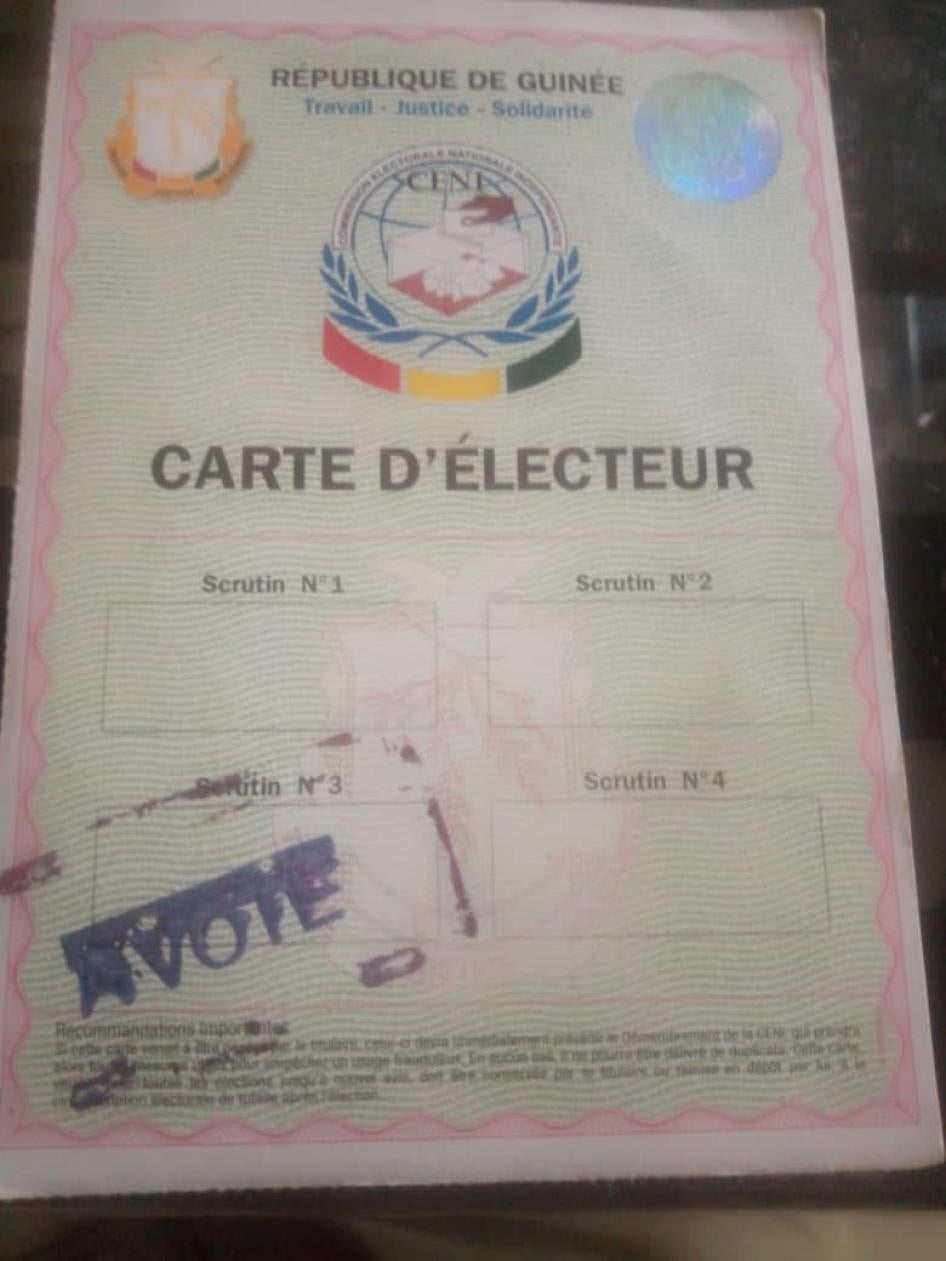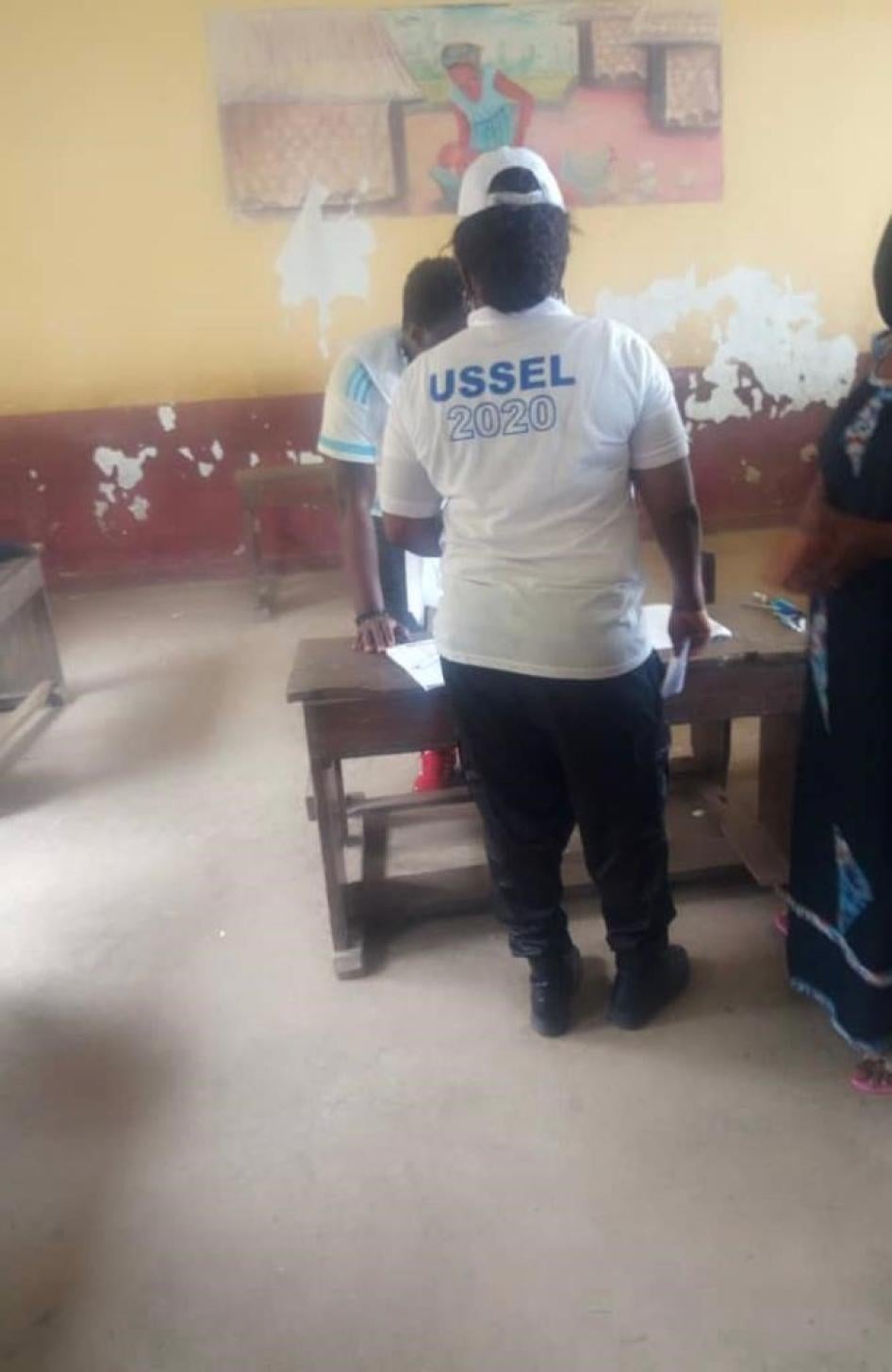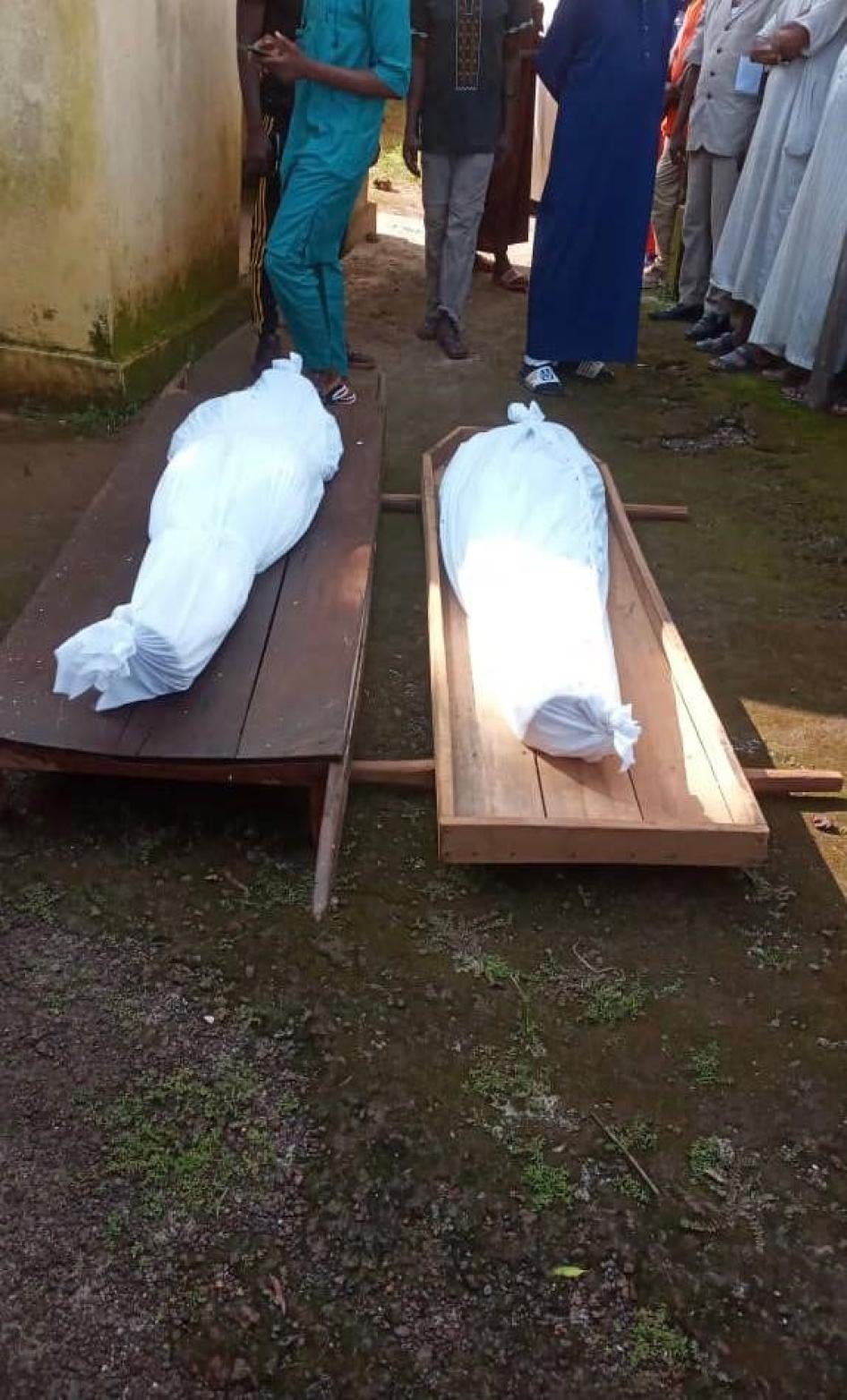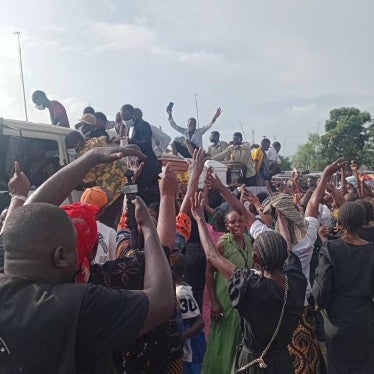(New York) – The post presidential-election period in Guinea has been marred with violence and repression, with at least 12 people dead, Human Rights Watch said today. Following the October 18, 2020 election, security forces used excessive force to disperse opposition-led demonstrations in the capital, Conakry.
The main opposition candidate, Cellou Dalein Diallo, was held under de facto house arrest, without charge, from October 20 to October 28. One of Guinea’s main online news outlets was suspended from October 18 to November 2, and internet and telephone networks were severely disrupted or shut down between October 23 and 27, making it difficult for people to communicate, get information, or report on unfolding events.
“The brutal crackdown on protesters and others in Conakry is part of a pattern of repression that undermined the credibility of the elections,” said Ilaria Allegrozzi, senior Africa researcher at Human Rights Watch. “The authorities should rein in security forces, investigate those implicated in abuses and hold them to account, while all political leaders should urgently instruct their supporters to refrain from using violence.”
Some protesters assaulted the police and gendarmes, throwing rocks and other objects. According to the government, the assault resulted in the death of six members of the security forces. One person died during intercommunal violence, while scores of people were injured during violence across the capital, including at least 29 with gunshot wounds or injuries from teargas allegedly caused by security forces.
On October 24, the electoral commission announced that incumbent President Alpha Condé won the election, with 59.5 percent of the vote. This win has allowed him to serve a controversial third term. Diallo announced on October 19 that he had won, and on October 24 rejected the official election results, alleging fraud, and called for mass demonstrations. On October 30, he appealed Condé’s victory at the country’s constitutional court. On November 7, the court confirmed Condé’s victory, rejecting the fraud allegations, and Diallo has since called for further demonstrations and civil disobedience.
Human Rights Watch interviewed 70 people by phone between October 17 and November 13, including 32 victims and witnesses to the violence, 15 relatives of victims, 3 medical workers, 3 journalists, 10 opposition party members, 5 civil society representatives, and 2 local authorities in Conakry. Human Rights Watch also reviewed government statements and analyzed photographs and video footage to corroborate victim and witness accounts. On October 27, Human Rights Watch shared its findings and requested responses to specific questions in a telephone conversation with Albert Damatang Camara, the security and civilian protection minister.
Camara rejected the allegation that the security forces killed anyone and said that “Many were killed by bullets fired from 12-caliber rifles, hunting guns, which are not used by our security forces.” He said that “Twenty-one people died since October 19 in post-election violence, including six members of the security forces and three children, the youngest of whom was 14 years old.” Camara stated that of the 21 victims,18 died in Conakry while the others died in the country’s interior. He also claimed that at least 18 of the victims were shot.
Human Rights Watch did not find any evidence that civilians fired guns during the violence. Camara’s position was at odds with the accounts of many witnesses, including a person who took part in the protests in Conakry’s Hamdallaye 2 neighborhood on October 19. “We were expressing our joy for Diallo’s victory when a police vehicle came in at full speed and fired teargas to disperse us,” the protester said. “People ran and then the police shot at us.” The witness said that 13-year-old Thierno Nassirou Sylla was shot in his face and “died on the spot.”
Human Rights Watch spoke to another witness to the killing and to a relative of the victim, who confirmed that the police shot Nassirou. Human Rights Watch also reviewed video footage showing the aftermath of the killing and photographs of his body.
In an October 22 statement, Camara said that violent demonstrators burned a military post in Conakry’s Niariwada neighborhood between October 19 and 21. According to authorities and media reports, violent protesters blocked a train in the Sonfonyah neighborhood on October 23 and killed three gendarmes and a soldier escorting the train to Conakry’s port. The authorities said that opposition protesters beat the four force members to death with machetes and other bladed weapons.
Camara said that investigations were ongoing to identify those responsible for the killings. On October 31, the prosecutor of the Conakry appeals court said that 325 people had been arrested in connection with the post-election violence. Human Rights Watch is not aware that they included any security force members.
Nationwide internet disruptions have made it difficult for Guinean and international journalists and human rights activists to cover and report on the violence. Netblocks, a civil society organization working on digital rights and cybersecurity on October 23 reported “major disruptions on leading cellular network operator Orange, with national connectivity registering at just 9% of ordinary levels,” as well as partial restrictions on other operators, including MTN and Cellcom, “limiting access to major social media and communication platforms.” The authorities have not issued any public statement about the internet restrictions which, Netblocks said, lasted from October 23 to October 27.
On October 18, the High Authority for Communication (HAC), the Guinean media regulatory body, suspended a news website, Guinéematin.com. “I was not even notified of the decision,” Nounou Baldé, the founder of the website, told Human Rights Watch. “It came right after our Live Facebook broadcasting of the vote counting. This decision has no legal basis and is a form of intimidation against independent journalism.” On November 2, the HAC announced that the suspension had been lifted.
International law and Guinea’s constitution protect the right to freedom of assembly and expression and prohibits excessive use of force by law enforcement officials. The United Nations Basic Principles on the Use of Force and Firearms states that law enforcement officials may use force only in proportion to the seriousness of the offense, and that the intentional use of lethal force is permitted only when strictly unavoidable to protect life. International human rights standards require internet-based restrictions to be both necessary and proportionate. The United Nations Human Rights Council has condemned measures by governments to prevent or disrupt online access to information.
The United States, France, and the European Union all condemned the post-electoral violence and urged the authorities to conduct credible investigations and to ensure justice and accountability. The African Commission on Human and Peoples’ Rights called on Guinean security forces to respect the right to life and physical integrity provided for by the African Union’s Charter and to avoid using lethal force to restore public order. Speaking from a military camp in Conakry on October 30, President Condé urged the security forces not to carry lethal weapons while policing demonstrations and to act in a “civilized way.”
On October 25, during a visit to Conakry, a delegation from the United Nations, African Union, and the Economic Community of West African States (ECOWAS), a regional bloc, urged Guinean authorities to remove security forces deployed around opposition leader Diallo’s residence.
“With tensions still running high and more opposition-led demonstrations planned, Guinean authorities should be vigilant in preventing more abuses,” Allegrozzi said. “Guinea’s regional and international partners should support accountability efforts and urge the government to bring the perpetrators of abuses to account.”
For more details and accounts from witnesses, please see below.
Pre-Election Period Marred with Violence, Restrictions on the Opposition
Guinean security forces have a long history of using excessive force against protesters, especially around elections. In March 2020, during legislative elections and the constitutional referendum that paved the way for Conde’s third term, they killed at least two people in Nzérékoré Forest region, and eight others were killed in Conakry, including two children. .
Tensions escalated in the lead-up to the October 18 presidential election during a campaign marked by violent incidents, hate speech, and divisive politics. On September 29, a violent mob attacked the motorcade of Prime Minister Kassory Fofana, in Labé. On October 11, ruling party supporters stopped a Diallo campaign rally in Kankan about 500 kilometers from Conakry. They blocked the road and began beating up opposition supporters and looting dozens of local businesses.
On October 16, security forces prevented Ousmane Kaba, a presidential candidate and leader of the opposition party, Party of Democrats for Hope (Parti des Démocrates pour l’Espoir, PADES) from holding a meeting in Siguiri, north-east Guinea. On October 17, police arbitrarily arrested three members of the opposition party Union of Democratic Forces of Guinea (Union des forces démocratiques de Guinée”, UFDG) in Diaraguerela, Forest region. They were released on October 22 without charge.
Post-Election Killings in Conakry by Security Forces
Human Rights Watch found that security forces, including police and gendarmes, used excessive force to disperse opposition-led demonstrations in several neighborhoods of Conakry –including Bambeto, Baylobaya, Bantounka, Cobayah, Hamdallaye, Sonfonyah, and Wanindara – firing teargas and in some cases live ammunition. Security forces shot dead at least 12 people, including 3 on October 19, 5 on October 21, 2 on October 22, and 2 on October 23. A 20-year-old woman also died on October 23. Human Rights Watch was unable to speak to those who witnessed that incident, but two family members said she was hit by a teargas canister fired by security forces. Below are accounts from a selection of the cases documented.
October 19
The day after the election, security forces shot Mamadou Saidou Diallo, a 14-year-old boy, in the back as he ran away when policemen and gendarmes fired live bullets to disperse demonstrators who had taken to the streets in Conakry’s Bantounka 1 neighborhood to celebrate Diallo’s announcement of victory, according to a witness and two family members.
The witness, a friend of Diallo, said:
Mamadou and I were out in the streets to express our happiness for Diallo’s victory. At the beginning, it was calm, but then gendarmes told us to go home. “If you don’t leave, we’ll shoot; we have the order to shoot,” they said. We thought it was wise to leave, but others wanted to stay. Gendarmes then fired teargas to disperse us, and then they fired live bullets. We ran, and Mamadou was hit in the back. He screamed. I picked him up, and a lady helped me. While we were carrying him to safety, in the chaos, a car hit us. The lady was injured, and Mamadou was also hit by the car.
Mamadou’s friend escaped injury and took Mamadou and the woman to a health center. A doctor at the health center who received Mamadou’s body said that he was already dead when he arrived. “A bullet had entered from his back and exited near his belly button,” he said. “The victim also showed fractures to his humerus and jaw, as well as wounds on his cheeks, consistent with accounts provided by the people who took the body to me and who said he was hit by a car.” Human Rights Watch reviewed a photograph showing Mamadou’s body and the gunshot wound.
A 16-year-old boy said he was shot in the left foot by a gendarme at ‘Concasseur’ roundabout in Conakry and that his friend, Abdoulaye ‘Diombo’ Diallo, age 17 or 18, was killed: “We were out celebrating Diallo’s victory when some pick-ups [trucks] full of gendarmes came. Some of them got off their vehicles and started shooting at the crowd. People ran. I ran too and was hit by a bullet. As I fell, I saw my friend falling. Someone took me to the hospital for treatment.”
Human Rights Watch spoke to another witness of the killing who confirmed the account provided by Diallo’s friend. Human Rights Watch also reviewed a photograph showing Diallo’s body after he was killed.
October 21
Two witnesses said security forces shot dead Boubacar Baldé, 28, the coordinator of the National Front for the Defense of the Constitution (Front national pour la défense de la Constitution, FNDC), a coalition of nongovernmental groups and opposition in Conakry’s Sonfoniyah neighborhood during opposition-led protests. One of the witnesses said, “We were in the street to say no to the third term. We threw rocks at the police and gendarmes. They fired teargas to disperse us and then started shooting. Baldé was shot in his thigh. I brought him to a health center in Sonfoniyah. He was losing too much blood. He was transferred to another health facility, but he died of his injuries.”
Human Rights Watch spoke to the doctor who treated Baldé at the health center in Sonfoniyah before sending him to another health facility. The doctor confirmed that Baldé had a deep gunshot wound on his left thigh. Human Rights Watch also spoke to a family member of the victim, who confirmed the killing.
Three witnesses said gendarmes fired teargas and live ammunition to disperse hundreds of opposition supporters who took to the streets in Conakry’s Baylobaya neighborhood. They said gendarmes shot two men, Souleymane Bah, 29, and Mamadou Diallo ‘Fady,’ 32, both drivers. Mamadou Diallo’s brother, who witnessed both killings, said:
Mamadou was hit in the side, while Souleymane was hit in his back. The small health center where we took them was not adequately equipped to treat them. The ambulance could not come to take him to a bigger hospital because all roads were blocked. The Red Cross could not come either because their premises had been attacked and ransacked. I begged the doctor to save Mamadou, but he had lost too much blood and died there of his injuries. He died in my arms.
Souleymane Bah died after he was transferred to another health center. The two men were buried together the following day. Human Rights Watch also spoke to three friends of the victims and reviewed photographs of their bodies showing injuries consistent with accounts of witnesses.
October 22
Three witnesses said that violent clashes erupted in Conakry’s Bambeto neighborhood as opposition supporters confronted the security forces, including policemen and gendarmes, throwing rocks at them and blocking the road. They said that the security forces used teargas and live ammunition to disperse the protesters and shot dead 20-year-old Mamoudou Pathé Bah. One witness said:
We were in the streets to express our opposition to Condé’s third term and to support the victory of our candidate Cellou. We threw stones at the gendarmes and policemen, who did not hesitate to respond. They fired teargas and then live bullets. There was an armored car with policemen and gendarmes parked in front of us. I saw a gendarme opening the door and firing. The bullet hit Mamoudou in his chest. I was beside him. I got really scared. People took him to a nearby health facility, but he was already dead. With others, we took his body to the Ignace Deen hospital. We also filed a complaint at the judicial police headquarters, but they did not give us a copy of it.
Two witnesses said gendarmes shot dead Youssouf Barry, 22, a driver, in Conakry’s Sonfoniyah neighborhood during altercations between opposition supporters and ruling party sympathizers. “There were tensions between the two sides,” one witness said. “Gendarmes came to disperse demonstrators and fired live bullets. He was hit in the chest and died on the spot.”
October 23
Two witnesses said that gendarmes shot dead Souleymane Barry, 29, a trader, in Conakry’s Cobayah neighborhood during violent clashes between opposition supporters and the security forces. A 37-year-old relative of the victim and witness to the killing said:
We were going to the mosque at about 12:30 p.m. when we saw people running away, as they were being chased by gendarmes. There were clashes between protesters and the security forces on the main road. Protesters threw rocks at the security forces, and they responded by shooting. We ran and Souleymane was hit by a bullet in his neck. I rescued him and brought him to a nearby health facility. But it was too late. He left two children behind and a pregnant wife.
Human Rights Watch also interviewed Barry’s father, who confirmed the death of his son.
Two witnesses said that police officers fired live bullets to disperse a crowd of opposition supporters in Conakry’s Koloma neighborhood, killing Mamadou Aliou Diallo, 24, a student: “We were together, by the roadside, between 10 and 11 a.m.,” one witness said. “I saw the police shoot him in the forehead from about 60 meters, and he fell in front of me. I brought him to a local health center, where the doctor could not treat him and suggested we take him to Donka hospital. We took him there, but he died at 4 p.m. the same day.” Human Rights Watch also spoke to two of the victim’s family members, who confirmed Diallo’s death.
Injuries Caused by Security Forces
Human Rights Watch spoke to three doctors who received and treated people who were wounded during the post-election violence in Conakry. One of them, whose health facility is in the Bantounka neighborhood, said he treated 36 people, including 6 women and 3 children, from October 19 to 28. Eleven had gunshot wounds, four had wounds caused by teargas, including burning, and one died of his injuries. The remaining 20 had other types of injuries, including 9 with stab wounds.
Another doctor working in Sonfonyah neighborhood said that he received seven people with gunshots wounds during the same period, four of whom died of their injuries. A third doctor in Wanindara neighborhood said he received twenty people, also between October 19 and 28, including eight with gunshot wounds, four with wounds caused by teargas, and the remaining eight with other light wounds.
October 21
A 25-year-old student said he was shot in the leg in Conakry’s Sonfonyah neighborhood at around 8 a.m. during opposition-led demonstrations. “Young people were protesting on the main road,” he said. “Gendarmes and police suddenly started shooting. There was sustained gunfire. I was frightened. It felt like I was in a war zone. As I ran away, I was hit in my leg. People took me to the Donka hospital, where I spent over a week. The bullet broke my left tibia, and I am yet to recover.”
October 22
A 38-year-old businessman said that he and two other men were shot in Conakry’s Cimenterie neighborhood as police came to break up clashes between members of the Malinké and Fulani ethnic groups:
A group of young ethnic Malinké armed with machetes, stones, scissors, and knives had come to our area and started burning vehicles belonging to the Fulani people. I was helping put down the fire. There were clashes between the two communities. The police came with a truck and fired teargas to disperse us. Some policemen came off the truck and started shooting at people. I was shot [in my left leg] from 40 to 50 meters away. Two other men were also shot. I was taken to a small local health center. There was no way for me to reach a more equipped hospital because roads were blocked. Now I cannot walk; I cannot work. I am just sitting at home, while Conakry’s on fire.
Human Rights Watch spoke to the two other men, who said they were shot by the police at the same place and time, including a 49-year-old driver who was injured in his left arm and an 18-year-old mechanic who was injured in his left foot.
Intercommunal Violence
Intercommunal violence erupted in Conakry on October 23 when hundreds of armed men from various ethnic groups, including Malinké and Konianké, considered to be sympathetic to the ruling party, attacked ethnic Fulani, perceived to be opposition supporters, in Enta Marché neighborhood. During the clashes, Yacouba Diallo, 67, a mechanic, was beaten to death and then burned in his home. At least one other home was also burned, and at least 10 shops were looted. “They ransacked my bakery; they took 10 flour bags and all the yeast,” a baker said. Human Rights Watch reviewed nine photographs and nine videos showing the destruction of property following the violence.











